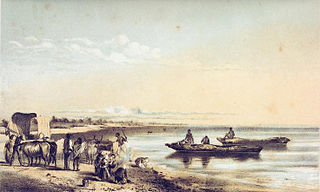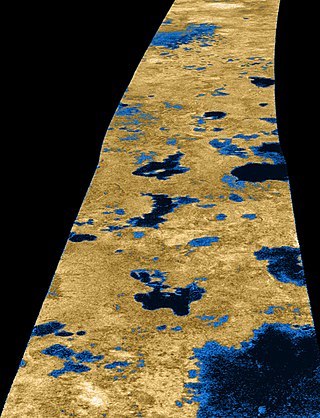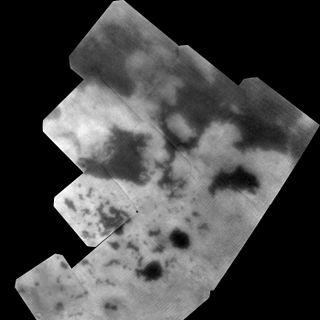
Lake Ngami is an endorheic lake in Botswana north of the Kalahari Desert. It is seasonally filled by the Taughe River, an effluent of the Okavango River system flowing out of the western side of the Okavango Delta. It is one of the fragmented remnants of the ancient Lake Makgadikgadi. Although the lake has shrunk dramatically beginning from 1890, it remains an important habitat for birds and wildlife, especially in flood years.

Lakes of ethane and methane on Titan, Saturn's largest moon, have been detected by the Cassini–Huygens space probe, and had been suspected long before. The large ones are known as maria (seas) and the small ones as lacūs (lakes).

Punga Mare is a lake in the north polar region of Titan, the planet Saturn's largest moon. After Kraken Mare and Ligeia Mare, it is the third largest known body of liquid on Titan. It is composed of liquid hydrocarbons. Located almost adjacent to the north pole at 85.1° N, 339.7° W, it measures roughly 380 km (236 mi) across, greater than the length of Lake Victoria on Earth. Its surface area is ~61,000 km2. Its namesake is Punga, in Māori mythology ancestor of sharks, rays and lizards and a son of Tangaroa, the god of the sea.

Jingpo Lacus is a lake in the north polar region of Titan, the planet Saturn's largest moon. It and similarly sized Ontario Lacus are the largest known bodies of liquid on Titan after the three maria. It is composed of liquid hydrocarbons. It is west of Kraken Mare at 73° N, 336° W, roughly 240 km long, similar to the length of Lake Onega on Earth. Its namesake is Jingpo Lake, a lake in China.

Eyre Lacuna is a feature on Saturn's largest moon, Titan, believed to be a currently dry bed of an intermittent hydrocarbon lake.

Mackay Lacus is the seventh largest of a number of hydrocarbon seas and lakes found on Saturn's largest moon, Titan. The lake is composed of liquid methane and ethane, and was detected by the Cassini space probe.

Abaya Lacus is one of a number of hydrocarbon lakes found on Saturn's largest moon, Titan.

Bolsena Lacus is one of a number of hydrocarbon lakes found on Saturn's largest moon, Titan.

Neagh Lacus is one of a number of hydrocarbon lakes found on Saturn's largest moon, Titan. The lake is composed of liquid methane and ethane, and was detected by the Cassini space probe.

Sotonera Lacus is one of a number of hydrocarbon lakes found on Saturn's largest moon, Titan.

Woytchugga Lacuna is one of the largest lakes of Titan.

Hammar Lacus is one of a number of hydrocarbon seas and lakes found on Saturn's largest moon, Titan.

Feia Lacus is one of a number of hydrocarbon seas and lakes found on Saturn's largest moon, Titan. It was named in 2007 on the basis of data taken by the space probe Cassini.

Koitere Lacus is one of a number of hydrocarbon lakes found on Saturn's largest moon, Titan. The lake is composed of liquid methane and ethane, and was detected by the space probe Cassini.

Müggel Lacus is one of a number of hydrocarbon seas and lakes found on Saturn's largest moon, Titan.

Ladoga Lacus is a geographical feature on Saturn's largest moon, Titan, named after Lake Ladoga, Russia. It is one of a number of "methane lakes" found in Titan's north polar region.

Kutch Lacuna is a large intermittent lake on Titan.

Nakuru Lacuna is the largest intermittent lake on Titan.











